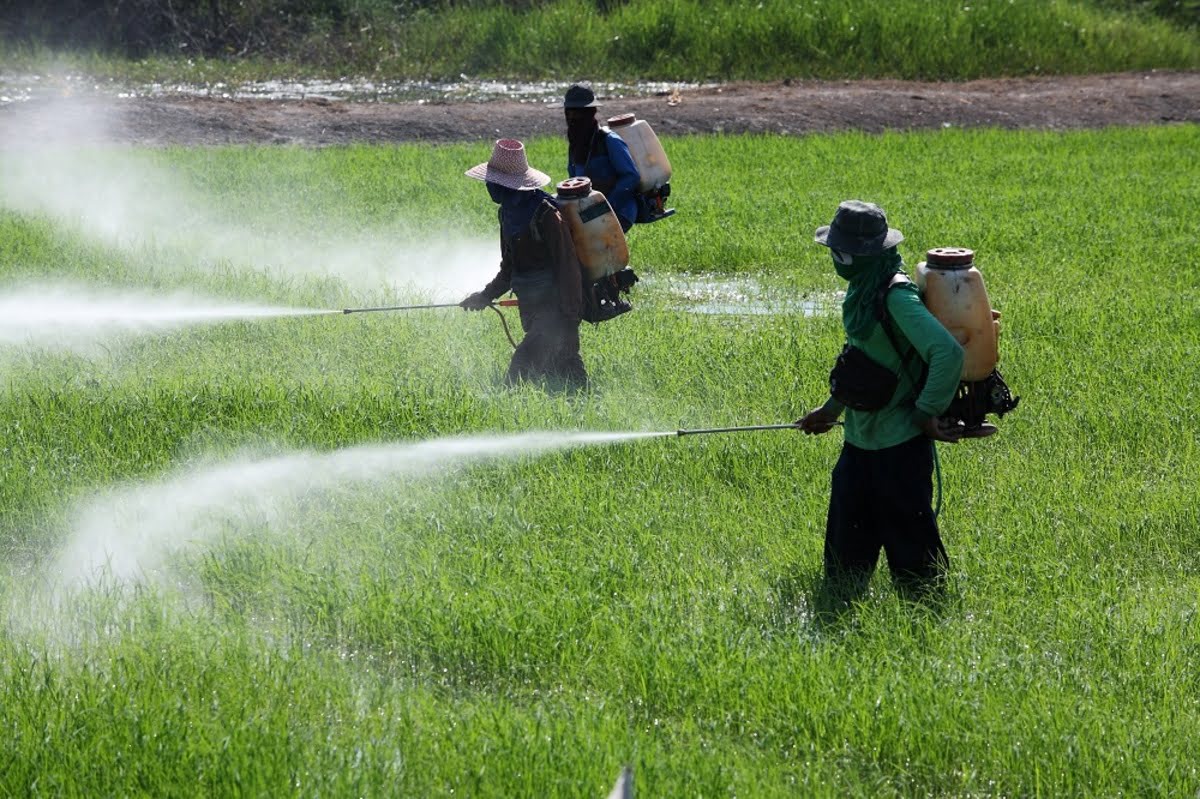Home>Gardening Basics>Understanding Soil>What Causes Soil To Be Acidic


Understanding Soil
What Causes Soil To Be Acidic
Published: February 4, 2024
Understanding soil and its acidity levels: discover what causes soil to be acidic and how it can affect plant growth and nutrient availability.
(Many of the links in this article redirect to a specific reviewed product. Your purchase of these products through affiliate links helps to generate commission for Chicagolandgardening.com, at no extra cost. Learn more)
Table of Contents
Introduction
Soil acidity is a critical factor that affects the growth and productivity of plants. Understanding the causes of soil acidity is essential for farmers, gardeners, and agricultural experts to optimize soil conditions and ensure sustainable crop production. Soil acidity refers to the measure of the soil’s pH level, indicating its alkalinity or acidity. A pH value below 7 is considered acidic, while a value above 7 indicates alkaline soil.
Soil acidity can have various impacts on plant health and nutrient availability. Acidic soils can restrict the uptake of essential nutrients like calcium, phosphorus, and magnesium, leading to nutrient deficiencies in plants. It can also affect the microbial activity in the soil, affecting the decomposition of organic matter and nutrient cycling. Furthermore, soil acidity can influence the solubility and availability of certain toxic elements, impacting plant growth and overall soil health.
This article aims to explore the causes of soil acidity, both natural and anthropogenic, and their effects on plant growth. We will delve into the methods of measuring soil acidity and discuss strategies for managing and correcting soil acidity. By understanding the factors contributing to soil acidity and implementing appropriate practices, farmers and gardeners can maintain optimal soil conditions for healthy plant growth and maximize their agricultural yields.
Definition of Soil Acidity
Soil acidity is a measure of the concentration of hydrogen ions (H+) in the soil solution. It is determined by the soil’s pH level, which indicates the soil’s acidity or alkalinity. The pH scale ranges from 0 to 14, with a pH of 7 considered neutral. Soils with a pH below 7 are acidic, while soils with a pH above 7 are alkaline. The level of soil acidity directly affects nutrient availability, microbial activity, and overall soil health.
The acidity of soil is primarily determined by the presence of certain ions, such as hydrogen (H+) and aluminum (Al3+). These ions are released into the soil solution through various natural and human-induced processes, leading to changes in soil pH. Soil acidity can vary across different regions and soil types, influenced by factors such as climate, geology, vegetation, and land management practices.
Acidic soils have a higher concentration of hydrogen ions, which can negatively impact plant growth and nutrient availability. The excess H+ ions can displace other essential nutrients, such as calcium, magnesium, and potassium, from soil particles, making them less available for plant uptake. This can result in nutrient deficiencies and hinder plant growth and development.
Soil acidity can also affect soil structure and microbial activity. Acidic conditions can reduce the aggregation of soil particles, leading to compacted soil and poor water infiltration. Additionally, it can impact the activity and diversity of soil microorganisms, which play a vital role in nutrient cycling, organic matter decomposition, and overall soil fertility.
Understanding the definition and implications of soil acidity is crucial for effectively managing and correcting it. By implementing appropriate soil amendment techniques and agricultural practices, farmers and gardeners can optimize soil pH levels and create favorable conditions for plant growth and productivity.
Factors Influencing Soil Acidity
Several factors contribute to the acidity of soil, both naturally and as a result of human activities. Understanding these factors is crucial for effectively managing soil acidity and creating suitable conditions for plant growth. Let’s explore some of the key factors influencing soil acidity:
- Parent Material: The type of rock or mineral from which the soil is formed can influence its acidity. For example, soils derived from granite or basalt tend to be more acidic due to the presence of minerals that release hydrogen ions.
- Climate: Climate plays a role in soil acidity through its influence on factors like rainfall and temperature. High rainfall areas can leach basic ions from the soil, resulting in increased soil acidity. In contrast, arid regions with low rainfall may have alkaline soils.
- Vegetation: The type of vegetation and its impact on the organic matter content of the soil can influence soil acidity. Certain plants, like conifers, produce organic acids that increase soil acidity. On the other hand, the decomposition of organic matter can release basic cations, reducing soil acidity.
- Land Management Practices: Human activities such as agricultural practices, deforestation, and land clearing can significantly affect soil acidity. Excessive use of nitrogen-based fertilizers can increase soil acidity over time. Soil erosion can also expose acidic subsoils, altering the overall soil pH.
- Water Quality: The quality of irrigation water can impact soil acidity. Water with high levels of dissolved minerals, such as calcium and magnesium, can help neutralize soil acidity. In contrast, water with a low mineral content may contribute to increased soil acidity.
These factors interact with one another and can vary in their influence depending on the specific location. It is essential to consider these factors when managing soil acidity to develop appropriate strategies and practices for maintaining optimal soil conditions.
Natural Causes of Soil Acidity
Soil acidity can occur naturally due to a combination of geological and biological processes. These natural causes play a significant role in determining the acidity levels of soils. Let’s explore some of the primary natural causes of soil acidity:
- Weathering of Minerals: The weathering of minerals in the soil can release acids that contribute to soil acidity. Minerals such as pyrite (iron sulfide) can oxidize in the presence of oxygen and water, producing sulfuric acid. This acidification process can lower the soil pH and increase soil acidity.
- Organic Matter Decomposition: The decomposition of organic matter in the soil can release organic acids. Microorganisms break down organic materials, such as plant residues and animal wastes, producing acids as by-products. Over time, these organic acids can accumulate and contribute to soil acidity.
- Absorption of Carbon Dioxide (CO2): Soils can absorb carbon dioxide from the atmosphere, leading to the formation of carbonic acid. This weak acid can gradually lower the soil pH and contribute to soil acidity. The rate of carbon dioxide absorption is influenced by factors like soil moisture and temperature.
- Natural Acidic Rainfall: Rainfall can be naturally acidic due to the presence of dissolved gases like carbon dioxide and sulfur dioxide. Acidic rainfall can directly lower the pH of the soil surface, resulting in increased soil acidity. This phenomenon is more prevalent in areas with high air pollution or volcanic activity.
- Afforestation: The establishment of forests in certain regions can contribute to soil acidity. Some tree species, like pines, release organic acids into the soil through their root exudates and decomposing leaf litter. Over time, this organic acid accumulation can acidify the surrounding soil.
These natural causes of soil acidity can vary in their intensity and effects depending on factors like climate, geology, and vegetation. It is crucial to consider these natural processes when managing soil acidity, especially in areas where they are more prevalent. Understanding the natural causes of soil acidity allows for the development of appropriate strategies to maintain optimal soil pH levels.
Anthropogenic Causes of Soil Acidity
Human activities have a significant impact on soil acidity. Anthropogenic causes of soil acidity result from various agricultural practices, industrial activities, and land management practices. These activities can alter soil pH and contribute to increased soil acidity. Let’s explore some of the primary anthropogenic causes of soil acidity:
- Excessive Use of Nitrogen-Based Fertilizers: Nitrogen-based fertilizers, commonly used in agriculture, can lead to increased soil acidity. The process of nitrification converts ammonium (NH4+) ions to nitrate (NO3-) ions, releasing hydrogen (H+) ions in the process, which in turn acidifies the soil.
- Acid Rain Deposition: Industrial activities and the burning of fossil fuels release pollutants such as sulfur dioxide (SO2) and nitrogen oxides (NOx) into the atmosphere. Overtime, these pollutants can be carried by rainwater and deposited on the soil as acid rain, increasing soil acidity.
- Land Clearing and Deforestation: Clearing land for agriculture or urban development can expose acidic subsoils, altering the overall soil pH and increasing soil acidity. Deforestation can also contribute to soil acidity by disrupting the natural balance of organic matter accumulation and nutrient cycling in the ecosystem.
- Industrial Pollution: Certain industrial activities can release pollutants and chemicals that contribute to soil acidity when they come into contact with the soil. For example, acid mine drainage from mining operations can release sulfuric acid into the soil, lowering its pH levels.
- Improper Waste Disposal: Improper disposal of solid and liquid waste containing acidic substances can also contribute to soil acidity. When acidic waste materials leach into the soil, they can lower its pH and increase soil acidity.
These anthropogenic causes of soil acidity highlight the importance of responsible land management and sustainable agricultural practices. Minimizing the use of nitrogen-based fertilizers, adopting proper waste disposal measures, and reducing industrial pollution can help mitigate the impact of anthropogenic activities on soil acidity levels.
Effects of Soil Acidity
Soil acidity has numerous effects on plant growth, nutrient availability, and overall soil health. Understanding these effects is crucial for implementing appropriate measures to manage and correct soil acidity. Here are some of the key effects of soil acidity:
- Reduced Nutrient Availability: Acidic soils can limit the availability of essential nutrients to plants. High soil acidity can lead to the leaching of nutrients like calcium, magnesium, and potassium, making them less available for plant uptake. This can result in nutrient deficiencies, stunted growth, and reduced crop productivity.
- Altered Soil Microbial Activity: Soil acidity affects the composition and activity of soil microorganisms. Acidic conditions can inhibit the growth and activity of beneficial microorganisms that contribute to nutrient cycling and organic matter decomposition. This can negatively impact soil fertility and nutrient availability for plants.
- Phytotoxicity: Soil acidity can increase the release and availability of certain toxic elements such as aluminum and manganese. Elevated levels of these elements in acidic soils can be toxic to plants, causing physiological disruptions and inhibiting their growth and development.
- Impaired Soil Structure and Water Infiltration: Acidic soils tend to have reduced aggregation of soil particles, leading to compacted soil structure. This can hinder root penetration and limit water infiltration, causing waterlogging and poor drainage. Consequently, plants may experience oxygen deprivation and have difficulty absorbing nutrients from the soil.
- Decreased Microbial Nitrogen Fixation: Soil acidity can hamper the ability of nitrogen-fixing bacteria to convert atmospheric nitrogen into plant-available forms. This can result in nitrogen deficiencies in plants and necessitate the use of supplemental nitrogen fertilizers.
- Shift in Soil pH Preferences: Different plants have specific pH preferences for optimal growth. Acidic soils may favor the growth of acid-loving plants while inhibiting the growth of plants that prefer neutral or alkaline soils. This can impact crop selection and productivity in agricultural systems.
Overall, the effects of soil acidity can be detrimental to plant growth, nutrient availability, and soil health. It is important to identify and address soil acidity issues through appropriate soil management practices to ensure optimal conditions for plant growth and sustainable agricultural production.
Measuring Soil Acidity
Accurate measurement of soil acidity is crucial for understanding the pH level and developing appropriate strategies for managing soil conditions. Various methods and instruments are available for measuring soil acidity. Here are some commonly used techniques:
- Soil pH testing: The pH level of soil can be measured using pH test kits or pH meters. These tools provide a quick and convenient way to determine the acidity or alkalinity of the soil. pH test kits typically involve mixing a soil sample with a testing solution and comparing the color change to a color chart to determine the soil pH.
- Soil Sampling and Laboratory Analysis: Soil samples can be collected from different locations within a field and sent to a soil testing laboratory for analysis. The laboratory utilizes specialized equipment and methods to measure soil acidity, including extracting the soil solution and measuring the pH using a pH meter or electrode.
- Electrometric Method: The electrometric method involves placing a soil sample in a salt solution and measuring the electrical potential difference between the soil and a reference electrode. This technique provides a more accurate and precise measurement of soil pH.
- Titration Method: This method involves adding a known volume of a strong base, such as sodium hydroxide (NaOH), to a soil sample and monitoring the pH change until neutralization is achieved. The amount of base required to neutralize the soil acidity provides an indication of the soil’s acidic properties.
- Indicators: Certain chemical indicators, such as phenolphthalein or bromothymol blue, can be added to a soil sample. The color change of the indicator is then used to determine the soil pH, as different indicators have specific color ranges corresponding to different pH levels.
It is important to follow standardized protocols and guidelines when measuring soil acidity to ensure accurate and consistent results. Regular monitoring of soil pH levels over time can help track changes and identify the need for soil amendment practices to manage and correct soil acidity.
Managing and Correcting Soil Acidity
Managing and correcting soil acidity is essential for maintaining optimal soil conditions and promoting healthy plant growth. Several strategies and practices can be employed to address soil acidity concerns. Here are some effective methods for managing and correcting soil acidity:
- Liming: Liming is the process of applying agricultural lime to acidic soils. Agricultural lime, which is primarily composed of calcium carbonate or calcium magnesium carbonate, helps to neutralize soil acidity by increasing pH levels. The amount of lime required depends on the soil’s current pH level and the desired target pH.
- Organic Matter Addition: Incorporating organic matter into the soil can help neutralize acidity over time. Organic matter, such as compost or well-rotted manure, contains carbonates, which act as buffering agents and help raise the pH of acidic soils gradually. Regular additions of organic matter can improve soil structure, enhance nutrient availability, and promote microbial activity.
- Proper Nutrient Management: Correcting nutrient imbalances is crucial when managing soil acidity. Soil testing can identify nutrient deficiencies or excesses that may contribute to soil acidity. Applying fertilizers based on soil test results, including balancing macronutrients and micronutrients, can promote proper nutrient uptake and improve overall soil health.
- Soil Erosion Control: Preventing soil erosion helps maintain the integrity of the topsoil and minimize the exposure of acidic subsoil. Implementing erosion control measures, such as contour plowing, terracing, and cover cropping, can minimize the movement of soil and maintain an adequate topsoil layer for healthy plant growth.
- Proper Irrigation Management: Managing irrigation practices can help reduce soil acidity. Irrigation water with high mineral content, such as calcium and magnesium, can help neutralize soil acidity. It is important to monitor the quality of irrigation water and implement appropriate filtration or treatment methods if necessary.
Regular soil testing is crucial when managing soil acidity to monitor pH levels and evaluate the effectiveness of corrective measures. It is essential to follow recommended application rates and guidelines for lime and other amendments to avoid over-liming or under-liming the soil.
By implementing appropriate management practices and corrective measures, farmers, gardeners, and agricultural experts can effectively manage and correct soil acidity, creating favorable soil conditions for optimal plant growth and maximizing agricultural productivity.
Conclusion
Soil acidity is a crucial factor that directly impacts plant growth, nutrient availability, and overall soil health. Understanding the causes, effects, and measurement of soil acidity is essential for effective soil management and sustainable agriculture. Natural causes, such as mineral weathering and organic matter decomposition, as well as anthropogenic causes like excessive fertilizer use and industrial pollution, can contribute to soil acidity.
Soil acidity can lead to reduced nutrient availability, impaired soil structure, and altered microbial activity, which can negatively affect plant growth and productivity. It is important to regularly measure soil acidity through methods like pH testing, soil sampling, and laboratory analysis to monitor and address any acidity issues.
Managing and correcting soil acidity involves various techniques, including liming, adding organic matter, nutrient management, erosion control, and proper irrigation practices. These strategies help neutralize soil acidity, improve nutrient availability, and enhance soil health, creating a favorable environment for plant growth.
By implementing these practices, farmers, gardeners, and agricultural experts can optimize soil conditions, maximize crop yields, and promote sustainable agriculture. It is crucial to carefully monitor soil acidity levels, follow recommended application rates, and adapt management practices based on soil conditions and crop requirements.
Managing soil acidity is not only vital for current crop production but also for preserving the long-term fertility and sustainability of agricultural lands. By maintaining optimal soil pH levels and addressing soil acidity issues, we can ensure the provision of healthy food crops, protect the environment, and support a sustainable future for agriculture.






